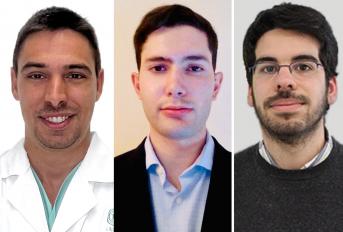Associação Portuguesa de Investigação em Cancro
Custo-efetividade e impacto clínico de um programa de rastreio endoscópico em doentes com neoplasia da cabeça e pescoço
Custo-efetividade e impacto clínico de um programa de rastreio endoscópico em doentes com neoplasia da cabeça e pescoço

Um estudo prospectivo unicêntrico demonstrou que um programa de rastreio endoscópico em doentes com neoplasia da cabeça e pescoço levou à deteção de neoplasia esofágica e/ou gástrica em 21,7% casos, a maior parte num estadio precoce e passível de resseção endoscópica. Uma análise económica de saúde mostrou que a implementação do programa é custo-eficaz em Portugal e que os resultados podem ser aplicáveis a outros países ocidentais.
1 Department of Gastroenterology, Unidade Local de Saúde São João, Porto, Portugal
2 Faculty of Medicine, University of Porto, Porto, Portugal
3 MEDCIDS-Department of Community Medicine, Information and Health Decision Sciences; Faculty of Medicine, University of Porto, Porto, Portugal.
4 CINTESIS@RISE-Health Research Network, Faculty of Medicine, University of
Porto, Porto, Portugal.
5 Gastroenterology Department, RISE@CI-IPOP (Health Research Network), Portuguese Oncology Institute of Porto (IPO Porto) & Porto Comprehensive Cancer Center (Porto CCC), Porto, Portugal.
6 Department of Pathology, Unidade Local de Saúde São João, Porto, Portugal.
7 Autonomous Management Unit, Unidade Local de Saúde São João, Porto, Portugal
8 Department of Otorhinolaryngology and Head and Neck Surgery, Unidade Local de Saúde São João, Porto, Portugal
9 IPATIMUP/ i3S, University of Porto, Portugal.
Methods: In this single-center study HNN patients eligible for curative treatment underwent screening esophagogastroduodenoscopy. We assessed the frequency, clinical, and pathological outcomes of EN and GN. The cost-effectiveness of an annual endoscopic screening for EN was evaluated from a societal perspective, using a Markov model and probabilistic sensitivity analysis. In addition, we performed a sensitivity analysis using data on the prevalence of detected EN lesions in the four largest previous Western studies on this topic.
Results: Forty-six HNN patients met the inclusion criteria and underwent endoscopic screening. Six EN were detected in five patients (10.9%, 95% confidence interval: 1.9-19.9%). Additionally, five GN were detected in five patients. Most patients had early-stage EN or GN (90%) and were treated with endoscopic resection (80%). Endoscopic screening strategy had an incremental cost-effectiveness ratio of 39 357.8 €/quality-adjusted life years gained, being cost-effective at a willingness-to-pay threshold of two times the Portuguese gross domestic product per capita. In the sensitivity analysis, it remained cost-effective when considering the prevalence of EN reported in Germany, France, and Brazil.
Conclusion: An endoscopic screening program identified EN or GN in a fifth of HNN patients, most presenting at an early stage. The program implementation appears to be cost-effective in Portugal. These results may be applicable to other medium-to-high-income Western countries.




